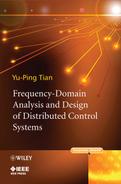Preface
This book is devoted to the study of distributed control systems, a very promising research area given the current rapid development of technologies of micro-sensors, micro-motors, sensor networks and communication networks. The main feature of the book is to adopt a frequency-domain approach to cope with analysis and design problems in distributed control systems. Frequency-domain methods utilize frequency response properties of subsystems (agents) and communication channels to characterize the stability and other performance criteria of the entire system. By comparison with time-domain methods, it is usually assumed to be more convenient to use frequency-domain methods for analyzing the robustness of the system against noise and dynamic perturbations. It will be shown in this book that frequency-domain methods are also powerful in scalability analysis of distributed control system.
The book consists of three parts. The first part includes Chapters 1, 2 and 3, and describes common features and mathematical models of distributed control systems; it also introduces basic tools that are useful for further analysis and design of the underlying systems, such as graph theory, frequency-domain stability criteria, scalability analysis based on differential geometric properties of frequency response plots, etc. The second part includes Chapters 4 and 5, and the third part includes Chapters 6 and 7. The second part focuses on the distributed congestion control of communication networks while the third part studies the consensus control of multi-agent systems. The second and third parts can be considered as the application of the general theory introduced in the first part. However, the theory is also developed in the last two parts for two particular types of distributed control systems. Moreover, many interesting and beneficial results are obtained when general theory is applied to concrete systems.
It is quite common to choose the congestion control and the consensus control for the study of distributed control systems. There are at least two reasons. Firstly, both types of control schemes emphasize cooperation in a group of agents although the starting points of the cooperation are somehow different. For the congestion control, the cooperation is realized through distributed real-time optimization of some common performance indexes, i.e., allocation of limited resources in networks. For the consensus control, the basis of the cooperation is to manipulate states (or output) of agents to reach some common value. The two cooperation approaches are widely used in many other practical distributed control systems, such as multi-robot control systems, localization and information fusion sensor networks, etc. Secondly, many theoretical problems such as stability, scalability and delay effect encountered in these two kinds of systems can be treated by using a unified frequency-domain method. Although distributed real-time optimization problems in congestion control usually lead to nonlinear models, the local dynamics around an equilibrium of a congestion control system can be described as a linear distributed feedback control system with a bipartite interconnection topology graph, which essentially has the same structure as a multi-agent system controlled by a consensus protocol. Nevertheless, consensus problems are different from congestion control problems in many aspects. For example, a multi-agent system driven by a consensus protocol has a continuum of equilibriums instead of an isolated equilibrium. This is perhaps why the Laplacian matrix of the interconnection topology graph plays a key role in consensus problems.
The time-delayed feedback control is introduced in this book as one of the basic design methods for distributed control systems. We study not only the effect of time delays, in particular various communication delays, on stability and scalability, but also the potential of time-delayed feedback control for enhancing the stability. This looks somewhat illogical. But in fact it is possible for time delay to have a dual character in feedback control systems, as in many other things in nature.
Some notions and results appearing in this book are new. They are mostly related to bipartite systems, symmetric systems, symmetric communication delays, commensurate self-delays, semi-stability test in the frequency domain, and high-order consensus. However, most of the material is based on the research results of the author with his collaborators and students, notably Jiandong Zhu, Hong-Yong Yang, Cheng-Lin Liu and Ya Zhang, to whom the author would like to express his sincere thanks. The author would also like to acknowledge the continuous support of the National Natural Science Foundation of China in the research topics of this book and in other related areas.
Parts of the book were taught on short courses listed below.
1. “Time-delayed Feedback Control”, Pre-conference workshop lecture on Chinese Control Conference, Harbin, 2006.
2. “Internet Congestion Control”, Summer school lecture at the School of Mechanics and Engineering Sciences, Peking University, Beijing, 2008.
3. “Coordination Control of Multi-agent Systems”, Summer school lecture at School of Mechanics and Engineering Sciences, Peking University, Beijing, 2010.
The author would also like to thank Prof. Zhong-Ping Jiang of New York University, Prof. Lin Huang of Peking University and Prof. Guangrong Chen of City University of Hong Kong for their invitations to present these lectures, which impelled the author to collect related materials scattered in his own and others' research publications.
Yu-Ping Tian
Southeast University, Nanjing
